The DHCP server uses the DHCP options to transmit additional configuration parameters to the DHCP clients. The vendor class ID (DHCP option 60) shows e.g. the type of device. DHCP option 43 is used by various device manufacturers to distribute additional information about network devices during the initial startup. The parameters themselves are manufacturer-specific. For the LANCOM Rollout Agent, for example, see Configuring the zero-touch rollout.
In LANconfig, the DHCP options are configured under . Click on Add to create a new entry.

- Option number
- Number of the option that should be sent to the DHCP client. The option number describes the transmitted information. For example "17" (root path) is the path to a boot image that a PC without its own hard disk uses to obtains its operating system via BOOTP.
Note: You can find a list of all DHCP options in RFC 2132 – DHCP Options and BOOTP Vendor Extensions of the Internet Engineering Task Force (IETF).
- Sub-option number
- Number of the sub-option that should be sent to the DHCP client. A DHCP option is made up of sub-options. For example, network devices such as SIP phones are often notified about where their firmware and configuration can be downloaded by means of DHCP option 43. The sub-option settings are defined by the respective manufacturer.
- Vendor-class mask
- When sending requests to DHCP servers, some DHCP clients submit a vendor-class ID and/or a user-class ID. These usually allow the client to be clearly assigned to a manufacturer or even a specific device class. For example, DHCP requests from LANCOM devices always contain the string "LANCOM" in the vendor-class ID, which is supplemented by the exact device type, if required. The DHCP server can use this information to provide the best suited DHCP options for the given device type. This is especially relevant for DHCP option 43, as its content is not standardized, but vendor-specific—the DHCP server has to transmit different information depending on the manufacturer or device type. The two fields "Vendor-class mask" and "User-class mask" can be used as filters. Strings that the DHCP server requires to be present in incoming requests can be entered here. The DHCP option is only delivered when the configured filter matches the DHCP request. The wildcards "*" (any number of characters) and "?" (exactly one character) can be used. If the fields are empty, they are ignored and the option is always delivered. For LANCOM devices, the entry here would be "*LANCOM*".
- User class mask
- Filter criterion used by some manufacturers for requests to the DHCP server. See also Vendor-class mask. Strings that the DHCP server requires to be present in incoming requests can be entered here. The DHCP option is only delivered when the configured filter matches the DHCP request. The wildcards "*" (any number of characters) and "?" (exactly one character) can be used. If the fields are empty, they are ignored and the option is always delivered.
- Network name
- Name of the IP network where this DHCP option is to be used.
- Type
- Entry type. This value depends on the respective option. For example, RFC 2132 defines the option "35" (ARP cache timeout) as follows:
ARP Cache Timeout Option This option specifies the timeout in seconds for ARP cache entries. The time is specified as a 32-bit unsigned integer. The code for this option is 35, and its length is 4. Code Len Time +-----+-----+-----+-----+-----+-----+ | 35 | 4 | t1 | t2 | t3 | t4 | +-----+-----+-----+-----+-----+-----+
This description tells you that this the type "32-bit integer" is used for this option.Note: You can find out the type of the option either from the corresponding RFC or from the manufacturer's documentation of their DHCP options. - Value
- With this field you define the contents of the DHCP option.
IP addresses are specified with the usual notation for IPv4 addresses, e.g. as "123.123.123.100", integer types are entered as normal decimal numbers, and strings as simple text.
Multiple values in a single field are separated with commas, e.g. "123.123.123.100, 123.123.123.200".
Note: You can find out the possible length of the option value either from the corresponding RFC or from the manufacturer's documentation of their DHCP options.
- Append Sub-Option
- For each sub-option of option 43, a separate option is created and transmitted. This switch allows several sub-options of DHCP option 43 to be appended. To do this, set this to Yes. Appending occurs when:
- Option-Number equals 43
- Sub-Option-Number is not equal to zero
- Above that in the table an option 43 with a sub-option number not equal to zero
Note: Note that each option can have a maximum of 255 characters.
Example: Transmit the "Classless Static Route" option from the DHCP server
To transmit the route 192.168.102.0/24 via 10.71.0.1 as a Classless Static Route Option (121) from the DHCP server, place the following entry in the table :
- Option number – 121
- Network name – name of the network to which the option should be transmitted to clients.
- Type – 8-bit integer
- Value – 24,192,168,102,10, 71, 0,1

